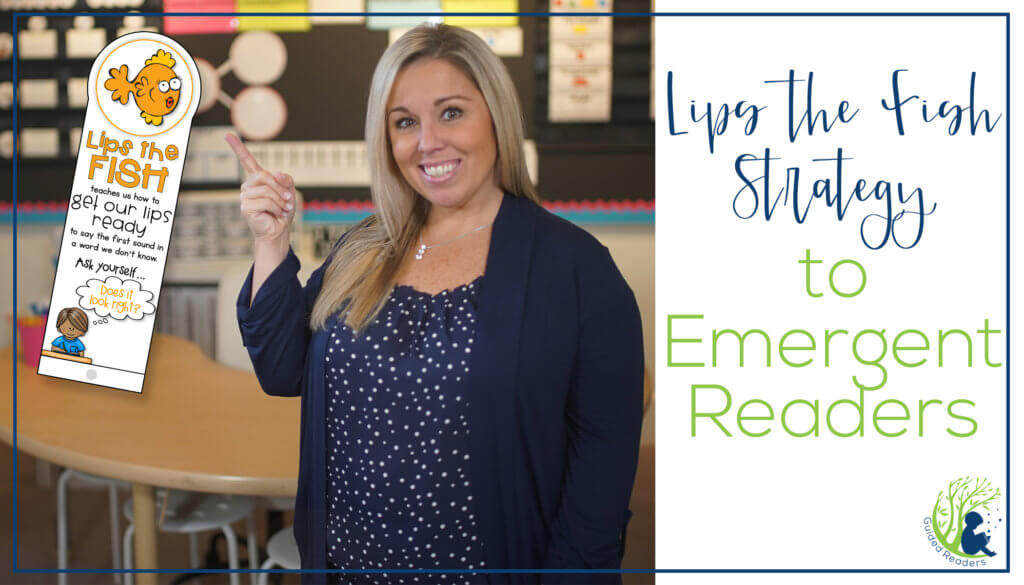Are you wondering how to effectively teach reading strategies to your Emergent readers? Readers at the Emergent level are reading on levels A through C. Graphophonic or visual cues are so important for readers at this level. Once they can recognize and use these cues, they’ll begin to see how letter-sound relationships help them solve unknown words. That means they’re ready to learn to use the “Lips the Fish” strategy! If you’re ready to learn how to teach it, keep reading!
The Eagle Eye strategy teaches readers to use their eyes to gain information from the pictures on the page, and the Lips the Fish strategy is the next logical step. Lips the Fish reminds readers to look at the beginning of a word and get their lips ready to say the first sound. This essential strategy centers on the Graphophonic or Visual cues students see as they focus on the printed letters of a word.
Lips the Fish is an important strategy for Emergent readers to learn; so let’s jump in and learn how to teach it!
Teaching the Lips the Fish Reading Strategy in a Whole Class Setting

In addition to having a plastic or stuffed toy fish to use as a prop, you’ll also want to provide strategy fans for students to refer to as they read. Each lesson in my Guided Readers online guided reading program contains strategy fan templates as well as a strategy instruction booklet to guide you as you teach. Print the fans and introduce them individually in a series of whole class mini-lessons. Use the strategies with big books to show how they work.
To introduce Lips the Fish, start by explaining, “Lips the fish has puckered lips because she is always ready to sound-out words! She gets her lips and mouth ready to say the first sound in a word she doesn’t know. This helps her figure out new words. Let’s try and be like Lips the Fish!”
Hold up letter cards and demonstrate how your lips move to form the letter sounds at the beginning of a word, such as “mop.” Say: “Lips the Fish presses her lips together to make the first sound in this word. It begins with the letter ‘m.’ ‘mmmm.’” Choose other short vowel CVC words, as well as long vowel words including vowel consonant + magic E words.
Teaching the Lips the Fish Strategy in Guided Reading
To see how you can teach and reinforce the Lips the Fish strategy during a guided reading small group, let’s look at how you might teach it using my book, “Getting Ready for Bed.”

(This book is available within Guided Readers, my new online guided reading program. I’ll share more about that later in this post)
After the Read & Prompt and book discussion, have students refer to their Lips the Fish strategy fan as you read page one of the text together. Cover the word “brush” with a card or sticky note, and then slowly reveal the first letter.
Ask the students, “Let’s see if Lips the Fish can help us make the beginning sound of this word. It starts with the letter ‘b.’ What should our mouth look like when we start to say a word that begins with ‘b’?” Model this, and then add the “r” sound.
“Let’s look at the next letter: ‘r.’ How should our lips look if we’re making the ‘rrrr’ sound? That’s right! All puckered up like Lips the Fish! Now let’s put those two sounds together and see if we can figure out the word: ‘brrrr…” “Brush.” Take a look at the letters in the word and ask yourself, ‘Does it look right?’”
Show How Strategies Work Together
Remind students that they can also use their Eagle Eyes to look at the picture for clues. Say, “Lips the Fish and Eagle Eye can work together to help us solve words! Let’s look at all those letters together: ‘brush.’ This sentence says ‘I can brush!’” We formed our lips to make the first sounds in the word and we said the word; and then we asked ourselves, ‘Does it look right?’ Yes! The sounds we made matched the letters we see. And the word ‘brush’ matches the picture we see on this page! I really like our new friend Lips the Fish, don’t you?’”
Move on to the following pages in the text, using the same strategy of uncovering the first letter of a word and having students get their lips ready to form the sound.
As soon as your Emergent readers know letters and sounds, they’re ready to learn this fun and helpful strategy! Thanks to their new friend Lips the Fish, your students will be able look at the beginning of a word and try to solve it by themselves, rather than giving up and just waiting for someone else to read it. Emergent readers may still be in she shallow end of the pool, but Lips the Fish helps them “Just keep swimming” towards fluency as they learn to read!
Guided Readers Can Help
If you found this post helpful, I hope you’ll head on over to my YouTube channel to see the video I’ve posted about teaching the Lips the Fish strategy. You’ll see plenty of examples of how I teach this strategy using guided reading texts from my new online guided reading program Guided Readers!
Teaching kiddos to read is no easy task! If you’ve ever felt like you’re in over your head with your guided reading instruction, you’re not alone! That’s why I created Guided Readers, your complete, done-for-you tool for teaching! Guided Readers takes the guesswork out of what to teach and how, with engaging, professionally leveled texts, complete lesson plans, a digital interactive reader, and time saving tools to help you stay organized. Guided Readers is a structured approach designed for today’s real classroom! It contains every effective tool you’ll need to take your students from “learning to read” to “reading to learn!” From phonics to comprehension, from vocabulary to reading fluency and guided writing, Guided Readers covers it all!
Thanks for joining me for this quick review of how to teach the Lips the Fish decoding strategy. If you missed my previous post on teaching the Eagle Eye strategy, you’ll find it here. Like our Disney friend Dory, when it comes to teaching reading, “just keep swimming.” And keep teaching those essential reading & decoding strategies!
Hugs,
Anna



